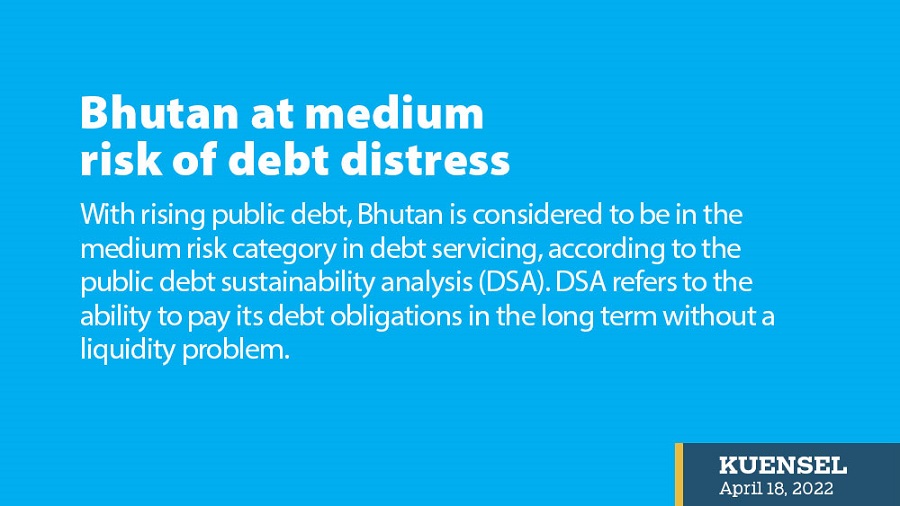
With rising public debt, Bhutan is considered to be in the medium risk category in debt servicing, according to the public debt sustainability analysis (DSA). DSA refers to the ability to pay its debt obligations in the long term without a liquidity problem.
Public debt sustainability has been one of the key anchors of the government’s fiscal policy. The DSA was conducted using the revised Debt Sustainability Framework (DSF) for Low-income countries(LIC), which was jointly developed by the IMF and World Bank.
According to the analysis, as of March 2022, Bhutan’s debt carrying capacity was classified as medium based on the composite indicator (CI) for the current DSA. Public debt has been covered for the current DSA on Public and publicly guaranteed (PPG) external and domestic debt of the general government and domestic debt of state-owned enterprises under the ministry of finance.
The benchmark for public debt (PPG external debt plus PPG domestic debt) for the country with medium debt-carrying capacity is the present value of PPG total public to GDP of 55 percent.
It states that if rated mechanically, the country’s public debt level would be rated as a “high risk” of distress since all indicative debt burden thresholds are breached even under the baseline scenario.
However, it mentioned that the judgment was used to arrive at the final risks rating of “moderate risks” of debt distress due to the unique nature of the country’s debt portfolio like more than 70 percent of external debt is hydropower debt, which is deemed self-liquidating.
It also states that hydro debt service coverage ratio is high, indicating the operating income is adequate to meet hydro debt servicing.
“Electricity export tariff is fixed by taking into account total project cost plus some margin and more than 98 percent of total public debt constitutes a fixed-rate debt, lowering interest rate risks,” it states.
The INR-denominated debt constitutes a major proportion of total external debt. However, the Ngultrum pegged at par with the INR lowers the exchange rate risks.
In addition, major shares of the hydropower debt are denominated in Indian Rupee.
The risks from hydropower debt is considered low because the debt servicing for hydropower loans from India starts only one year after the commissioning of the project, ensuring revenue inflow is in place when the debt servicing starts, thus mitigating the liquidity risk.
The export tariff for electricity is set by taking into account the overall cost of the project, including the projected debt servicing cost. This implies that there would be revenue from the sale of electricity that would provide an adequate cushion for debt servicing.
Meanwhile the public debt-to-GDP rose further at the end of FY 2020-21 to 134 percent. The drastic increase in the ratio was due to a higher level of borrowing from both external and domestic borrowing during the year to meet financing requirements for Covid-19 measures.
The analysis also states that the growth in the medium and long-term will be mainly driven by the commissioning of ongoing hydropower projects in the next three years.
It states that the commissioning of hydropower projects will significantly increase the country’s export to India, while also supporting the financing of Bhutan’s forthcoming 13th Plan through increased revenue contribution to the government in the form of royalty and taxes.
In addition, the opening of the country to tourists is also expected to have a significant positive impact on the medium- and long-term economic growth.
For the 13th FYP, which will start from July 2023, the annual average growth rate of government investment has been projected at 12 percent.
“Domestic revenue is also expected to improve significantly during the plan period due to the commissioning of ongoing hydropower projects, an improved collection due to better enforcement, digitisation, and fiscal and tax reforms,” it states.
Export of electricity in the medium-term in 13th FYP is projected to average Nu 65.77B per year, compared to the annual average of Nu 23.47B during the 12th FYP.
The Public Debt Policy 2016 also stipulates DSA as one of the risk assessment and monitoring tools and requires the ministry of finance to conduct a periodic DSA to monitor the risks and potential vulnerabilities of Bhutan’s public debt.



